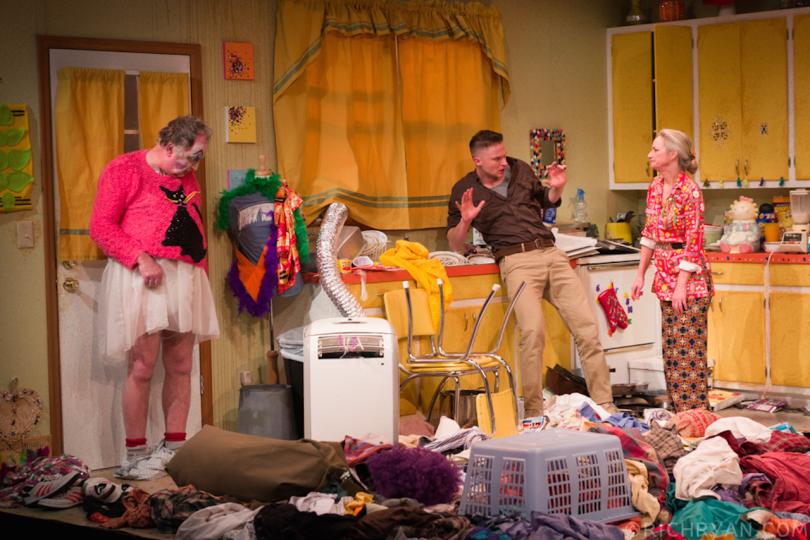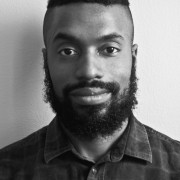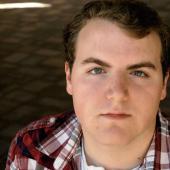Emerging Artist Profile: Trevor Bowen

As someone who moonlights as a costume designer, I rarely ever work with other costumers. I know of others, and I have seen their work, but I really only know them in passing – not acquainted enough to even be Facebook friends. This is not a new woe; I have heard it from design colleagues, wishing they too knew others in their field. So I figured I could do an Emerging Artist interview that would be the perfect opportunity to spread scenographic insight to those curious about artists who make clothes for imaginary people.

Trevor Bowen, who has only been in town for three years, has been one costume designer in particular I have been following, ever since I saw his nuanced work on Theatre Latte Da’s Our Town. With consistent credits from reputable theater companies, graduate training, and professional experience far from our Midwestern pocket, I knew he would have insight into the business, the director-designer collaboration, and the ever on-going “graduate school debate”. I feel that these are all questions young designers wonder about and struggle over during their greenhorn years.
Trevor’s studio is located in a basement of an apartment building. Although it was a small room, it was full of creative energy - overflowing with sewing supplies, fabric bundles, renderings from shows gone by, and Goodwill bags piled on top of each other. A true artist’s workshop.
What made you want to do costume design?
I started off in high school as an actor - that was where the ‘theater thing” hit me. I thought it was really cool to be on stage. I went to undergrad [at Southwestern State University] with an acting emphasis. We did this show called Philip Glass Buys a Loaf of Bread by David Ives. And I hated it! It was a challenge, but there was nothing fulfilling. I hated being on stage. At that school we had revolving assignments, so I did wardrobe on Tartuffe next. And I loved it--I loved clipping threads and people not knowing about this whole other world backstage. It was amazing to walk behind a scrim to help make a quick change while the audience having no idea about the change - just clueless! That was the real magic.
When I got to grad school [West Virginia University] there was such a learning curve. I didn’t have any technique--like an understanding of line, form, color, shape . But I wanted to learn. I was learning how to really dig into a script.
What brought you to the Twin Cities?
I got a job at Long Wharf as the assistant shop manager. I came back to Long Wharf after my (that) contract ended as the design assistant. That season was really fruitful--there were many designers with clear, concise, imaginative designs. They were also very generous and kind.
After that year, one of the designers texted me about the design assistant job at the Guthrie. And I was like, “What the fuck are you talking about?” ‘Cause that theater was not on my radar at all ‘cause I was in Connecticut and living a bit in New York. And like why would I leave? I thought that text was a joke ‘cause we only worked on one show together. I was really unsure because I thought it was time for me to move to New York; I knew my time in Connecticut was over. But this opportunity came up.
There were three designers that worked here [The Guthrie] who had sort of mentioned my name to Amy, the costume director. And, at the time, I didn’t really understand how competitive that job is and how important the Guthrie is nationally. I figured I just really needed to work at a really big house ‘cause I never had that.
There were designers I worked with at Long Wharf [at the Guthrie then]. It was like, “Hey girl! what’s up!?” That job had a year long contract, I had every intention on not being here after--I was going to dip in, learn, and leave. I had everything packed up, and then I got a call from Elizabeth McNally over at Pill House[Pillsbury House Theatre] saying that they needed a designer for a show. I had no work out East, so I agreed.
I was exposed to a whole other theatrical community there. ‘Cause even though it was nine to five at the Guthrie, my life was really just there. I didn’t do any work in the community. I had no sense on the depth of the community here, and the type of work that is being done. So after being at the Pillsbury House, l was like, “Shit, I can work at a theater that’s also a community center!? Where a child could literally grow up in the arts--from the daycare to the the Chicago Avenue Arts Project.” It’s amazing--It’s really beautiful that they can grow up through the arts. And eventually perform on the main stage? I don’t know any place like that in Connecticut. It warmed my heart to work on a show like that. The show was the road weeps, the well runs dry; it was really fucking hard but really satisfying at the same time.
So then I was like: OK, I can work here and make a life doing design.
How would you describe the Twin Cities theater scene?
Diverse. Multi-hued. I think it is dynamic. I think right now, honestly, there is a bit of a disconnect between smaller houses and as you move up to larger spaces. I don’t know why.
Disconnect? Like appreciation? Understanding? Artistically?
Maybe appreciation? Maybe access? Something like that? Whatever that means. It could be ticket prices? It could be the diversity? There is a lot of theater, but sometimes it seems there’s a discrepancy.
What were some of your early life influences?
Three years before Long Wharf, I was just doing summer stock at Contemporary American Theater Festival. When I wasn’t doing that, I was working at Banana Republic. Selling clothes to people is not the same as designing clothes for the stage--as I found out. But being there helped me understand the psychologically on the type of shopper they target. And I think that whole time I was there, I didn’t realize that I was sorta of learning how it informs your design work on a contemporary show. You understand the subtle theme and nuance of like a plaid shirt that’s really boxy and a plaid shirt that’s really fit. It makes such a big difference.
So I really learned about contemporary clothes. For me, fashion is a storytelling tool. I didn’t have that break between undergrad and graduate school--many designers take a year or so off and work in a costume shop or small freelancing gigs. Working there[at Banana Republic] was that time for me - just after my MFA instead.
How do you describe the correlation (or association?) between actor and the costume design?
Those conversations are interesting. I am surprised that there is so much letting go with inhabiting a role; maybe that is one way to interpret acting. Acting is still kind of magical to me, which I love--I don’t fully understand it, and I don’t want to.
With garments, like, it is the same thing: it is psychological. It is just maybe more physical? More immediate and physical sometimes. Like, that actor will have to lace up their shoes and, yes, it has 20 eyelets. You know? This will help you--it will help you slow down, take that time, and see what it feels like to get dressed as that character. Or to have to put your shoes on first ‘cause you’re gonna get strapped into a corset and your ass can’t bend over. And none of those are bad things! They are all tools.
What made you choose graduate school? How do you think it's influenced your work?
I choose graduate school because I felt like I needed that extra TLC. But I had things to offer to the program at that school as well; I could come as an open book. I had basic skills, and I knew I could teach, so I taught a sewing class. I knew I needed more training. I knew I didn’t know that much.
Would you recommend graduate school to others?
I recommend real world experience. It’s a personal decision. For me, I needed it. I know many who did not, and they make more money than me. It depends on you as an artist and sort of how you receive things; how you understand “you” and the “world”. It’s personal.
So if a young designer came to you and asked, “I am interested in going to graduate school. What aspects should I look for? Or even avoid?”
I would make a list on what you think your skills are and what your deficiencies are--be very honest with yourself, “I can sew” or “I can’t sew”. Be specific. Even like, “I like these colors” because you need to be aware if you have a tendency to be monochrome in your personal aesthetic--to understand that is your personal aesthetic. Be brutally honest with yourself. And when you go look for graduate schools, ask very specific questions. I think the whole point of that relationship--and it is a relationship--with that graduate program is that you need to get as much as you can. You should never leave school feeling, “Well, I didn’t learn everything.” Not that of course you will learn everything, but I feel there should be enough meat in that program to take whatever you want from it.
What is your aesthetic?
I don’t think I have one.
Well, let’s say in 30 years, you are a world famous designer. And people are studying your work. What do you think they would say? Or do you think maybe designers shouldn’t have that?
What I try to do is make it look as real as possible; “real” being relative to the show. But I just hope they look real and appropriate. l am always so concerned it won’t look that way--that it won't be clear.
You are giving a seminar to budding directors on the director-designer collaboration and process. What would your main takeaways be?
I think it is important to know and stress how important their concept is for the show, or to say very clearly that there isn’t one, or that the process is going to be organic. I put so much trust and faith into the director that they are the leader--they are the captain, they are the guiding hand of the ship.
I am here to help their hopes and dreams come true, right? It is not about me. It is about telling a really beautiful, clear story. I don’t need them to have an immediate answer for when I show them something or talk about something; it is an ongoing conversation. Just to be honest about that and say it.
I do not care if the director has no experience with clothes - I think it makes the conversation more fruitful. I am more than happy to explain if I feel strongly about a choice. But it is on you, as the designer, to be able to answer questions on clothing and palette, and an understanding that it is completely on you: the onus on color and texture. For the director, it is about concept/feeling/movement.
So can you sum up good, collaboration?
Being malleable. I feel it is important to be very clear--however that happens. I should be open enough and not in my own head that I can ask questions to draw out what they’re thinking.
And not being afraid to show what you have. I totally bring in pictures on the first rehearsal and say, “I really like this and this.” . . . You cannot take things personally: it is a job. If it doesn't work, then it doesn’t work. It is more about if it is right for the production.
I am a very visual person. I use Pinterest, even just for myself to do research or to add stuff to my artistic crockpot. What about you? What is your process?
It is a combination of things. I love the visual. Often times it can take the place of a lot of unneeded dialogue during that initial conversation. I often do a collage or Pinterest, or even a Dropbox full of images.
In addition I might do an e-mail that sort of gives very specific details for each specific character. I add notes to the collage as well, so the director can start to see it feels like “this” for that character. Sometimes I draw too or the collages get more specific, because it is always a barrage of images with me saying, “I think all of these are amazing! What do you think!?” So we can edit together. When I sketch, I write a lot [of notes] on them.
(Trevor reaches behind me and pulls out a binder from a pile. It is from his recent production of The Octoroon at Mixed Blood. It is full of character notes, detailed renderings, fabric swatches, and visual aids.)
What is the hardest part of being a costume designer?
The money or the resources for it. Sometimes you have a very specific idea on what something is, and everyone is in agreement about it, but it could be time or money that causes problems.
What is your dream production?
I guess it would be Blood Knot by Athol Fugard. I worked on that show in undergrad, and I think every once in awhile about it. Knowing what I know now, and with a costume shop support, I feel it would be more fun to design. Now that I am sane and not a crazy little undergrad. It would be so much fun to get the nuance of those two brothers. It is a small show and I love that, to be able to really dig deep in their garments. And with a full costume shop staff, to really take the time to age and distress the stuff. I would love the show to be in a small space too.
Trevor has designed costumes at the Contemporary American Theater Festival: Modern Terrorism, The Exceptionals, Race, We Are Here, Inana, The Eelwax Jesus 3D Pop-up Music Show, and History of Light. Trevor has also designed costumes at Gateway Playhouse for: 9 to 5, Sunset Boulevard, and Twist and Shout. Assistant costume design credits include: Guthrie Theater 2012-2013 Season, Three Sisters, Steppenwolf Theater, Jess Goldstein costume designer; February House, The Public Theater and Long Wharf theater 2011-2012. In the Twin Cities he has worked with Theatre Latte Da, Ten Thousand Things, Mixed Blood, Park Square and more. Trevor holds an M.F.A. in costume design from West Virginia University.
You can see Trevor’s upcoming designs in: Lullaby (Theatre Latte Da), Nina Simone: Four Women (Park Square theater), DJ Latinidad (Mixed Blood), and The Upstairs Concierge (Mixed Blood Theatre).




